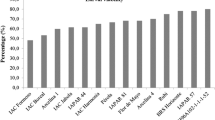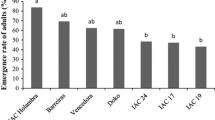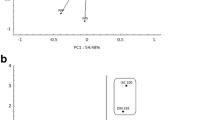Abstract
Soybean looper, Chrysodeixis includens (Walker), is one of the most destructive pests of soybean in the southern U.S. Soybean looper defoliation exceeding 20% from R3 (pod initiation) to R5 (pod fill) can result in significant yield loss. In addition, soybean looper is highly resistant to many insecticides. An alternative to insecticide control is induced host plant resistance. In this study, a total of four experiments over 2 years were conducted in which three different elicitors of SAR (systemic acquired resistance), Actigard 50WG (acibenzolar-S-methyl), Regalia (extract of Reynoutria sachalinensis), and methyl jasmonate (MeJA), were applied to soybean at different plant stages to determine if these chemicals could induce plant resistance and lower soybean looper fitness. None of the elicitors of SAR significantly affected soybean looper mortality. However, Actigard 50WG, MeJA, and Regalia had adverse effects on developmental time, defoliation, and pupal weight of soybean looper. Induced effects by Regalia on soybean looper were very limited compared to Actigard 50WG and MeJA. A single application of MeJA reduced pupal weight by 6.8% and delayed larval development by 14.3%. Soybean seed production was not affected by application of elicitors. In conclusion, the results suggest that exogenous elicitors applied in the field can trigger plant resistance against herbivores and this low level of host plant resistance may effectively lessen pest pressure by favoring natural enemy population regulation without reducing seed production.


Similar content being viewed by others
References
Accamando AK, Cronin JT (2012) Costs and benefits of Jasmonic acid induced responses in soybean. Environ Entomol 41:551–561
Babu RM, Sajeena A, Samundeeswari AV, Sreedhar A, Vidhyasekeran P, Reddy MS (2003) Induction of bacterial blight (Xanthomonas oryzae pv. oryzae) resistance in rice by treatment with acibenzolar-S-methyl. Ann Appl Biol 143:333–340
Bi JL, Felton GW, Mueller AJ (1994) Induced resistance in soybean to Helicoverpa zea: role of plant protein quality. J Chem Ecol 20:183–198
Boethel DJ, Mink JS, Wier AT, Thomas JD, Leonard BR, Gallardo F (1992) Management of insecticide resistant soybean loopers (Pseudoplusia includens) in the southern United States. In: Copping LG, Green MB, Rees RT (eds) Pest management in soybean. Society of Chemical Industry, Essex, pp 66–87
Boughton AJ, Hoover K, Felton GW (2005) Methyl Jasmonate application induces increased densities of glandular trichomes on tomato, Lycopersicon esculentum. J Chem Ecol 31:2211–2216
Brown SA (2012) Evaluating the efficacy of methoxyfenozide on Louisiana, Texas, and the Mid-Southern soybean looper populations. Louisiana State University. Electronic Thesis. Baton Rouge
Buzi A, Chilosi G, De Sillo D, Magro P (2004) Induction of resistance in melon to Didymella bryoniae and Sclerotinia sclerotiorum by seed treatments with acibenzolar-S-methyl and methyl jasmonate but not with salicylic acid. J Phytopathology 152:34–42
Carey JR (1993) Applied demography for biologists with special emphasis on insects. Oxford University Press, New York
Chen M (2008) Inducible direct plant defense against insect herbivores: a review. Insect Sci 15:101–114
Chiang HS, Norris DM, Ciepela A, Oosterwyk A, Shapiro P, Jackson M (1986) Comparative resistance in soybean lines to Mexican bean beetle. Entomol Exp Appl 42:19–26
Cipollini DF, Redman AM (1999) Age-dependent effects of jasmonic acid treatment and wind exposure on foliar oxidase activity and insect resistance in tomato. J Chem Ecol 25:271–281
Cole DL (1999) The efficacy of acibenzolar-S-methyl, an inducer of systemic acquired resistance, against bacterial and fungal diseases of tobacco. Crop Protect 18:267–273
Daayf F, Schmitt A, Bélanger RR (1995) The effects of plant extracts of Reynoutria sachalinensis on powdery mildew development and leaf physiology of long English cucumber. Plant Dis 79:577–580
Dann E, Diers B, Byrum J, Hammerschmidt R (1998) Effect of treating soybean with 2,6-dichloroisonicotinic acid (INA) and benzothiadiazole (BTH) on seed yields and the level of disease caused by Sclerotinia sclerotorium in field and greenhouse studies. Eur J Plant Pathol 104:271–278
Dietrich R, Ploss K, Heil M (2005) Growth responses and fitness costs after induction of pathogen resistance depend on environmental conditions. Plant Cell Environ 28:211–222
Faessel L, Nassar N, Lebeau T, Walter B (2007) Effects of the plant defense inducer, Acibenzolar-S-Methyl, on hypocotyl rot of soybean caused by Rhizoctonia solani AG-4. J Phytopathology 156:236–242
Fehr WR, Caviness CE, Burmood DT, Pennington JS (1971) Stages of development descriptions for soybeans, Glycine max (L.) Merrill. Crop Sci 11:929–931
Felland CM, Piter HN, Luttrell RG (1990) Resistance to pyrethroid insecticides in soybean looper (Lepidoptera: Noctuidae) in Mississippi. J Econ Entomol 83:35–40
Franceschi VR, Krekling T, Christiansen E (2002) Application of methyl jasmonate on Picea abies (Pinaceae) stems induces defense-related responses in phloem and xylem. Am J Bot 89:578–576
Funderburk J, McPherson R, Buntin D (1999) Soybean insect management. In: Heatherly LG, Hodges HF (eds) Soybean Production in the Midsouth. CRC Press, Boca Raton, pp 273–290
Goralch J, Volrath S, Beiter GK, Hengy G, Beckhove U, Kogel KH, Oostendorp M, Staub T, Ward E, Kessmann H, Ryals J (1996) Benzothiadiazole, a novel class of inducers of systemic acquired resistance, activates gene expression and disease resistance in wheat. Plant Cell 8:629–643
Gordy JW, Leonard BR, Blouin D, Davis JA, Stout MJ (2015) Comparative effectiveness of potential eicitors of plant resistance against Spodoptera frugiperda (JE Smith) (Lepidoptera: Noctuidae) in four crop plants. PLoS ONE 10:e013668
Herzog DC (1980) Sampling soybean looper on soybean. In: Kogan M, Herzog DC (eds) Sampling methods in soybean entomology. Springer, New York, pp 141–168
Inbar M, Doostdar H, Sonoda RM, Leibee GL, Mayer RT (1998) Elicitors of plant defensive systems reduce insect densities and disease incidence. J Chem Ecol 24:135–149
Jensen RL, Newsom LD, Gibbens J (1974) The soybean looper: effects of adult nutrition on oviposition, mating frequency, and longevity. J Econ Entomol 67:467–470
Johnson MT, Campbell SA, Barrett SC (2015) Evolutionary interactions between plant reproduction and defense against herbivores. Annu Rev Ecol Evol 46:191–213
Karban R, Baldwin IT (1997) Induced responses to herbivory. University of Chicago Press, Chicago, p 319
Karban R, Kuć J (1999) Induced resistance against pathogens and herbivores: an overview. In: Agrawal AA, Tuzun S, Bent E (eds) Induced plant defenses against pathogens and herbivores: biochemistry, ecology, and agriculture. The American Phytopathological Society Press, St. Paul, pp 1–18
Kempel A, Schädler M, Chrobock T, Fischer M, van Kleunen M (2011) Tradeoffs associated with constitutive and induced plant resistance against herbivory. Proc Natl Acad Sci USA 108:5685–5689
Kogan M, Fischer DC (1991) Inducible defenses in soybean against herbivorous insects. In: Tallamy DW, Raupp MJ (eds) Phyto-chemical induction by herbivores. Wiley, New York, pp 347–378
Kogan M, Turnipseed SG (1987) Ecology and management of soybean arthropods. Ann Rev Entomol 32:507–538
Korth KL, Thompson GA (2006) Chemical signals in plants: jasmonates and the role of insect-derived elicitors in responses to herbivores. In: Tuzun S, Bent E (eds) Multigenic and induced systemic resistance in plants. Springer, New York, pp 259–278
LaMondia JA (2008) Actigard increases fungicide efficacy against tobacco blue mold. Plant Dis 92:1463–1467
Leonard RB, Boethel DJ, Sparks AN, Layton BM, Mink JS, Pavloff AM, Burris E, Graves JB (1990) Variations in response of soybean looper (Lepidoptera: Noctuidae) to selected insecticides in Louisiana. J Econ Entomol 83:27–34
Lin H, Kogan M (1990) Influence of induced resistance in soybean on the development and nutrition of the soybean looper and the Mexican bean beetle. Entomol Exp Appl 55:131–138
Mascarenhas RN, Boethel DJ (2000) Development of diagnostic concentrations for insecticide resistance monitoring in soybean looper (Lepidoptera: Noctuidae) larvae using an artificial diet overlay bioassay. J Econ Entomol 93:897–904
Mészáros A, Beuzelin JM, Stout MJ, Bommireddy PL, Rita Riggio M, Leonard RB (2011) Jasmonic acid-induced resistance to the fall armyworm, Spodoptera frugiperda, in conventional and transgenic cottons expressing Bacillus thuringiensis insecticidal proteins. Entomol Exp Appl 140:226–237
Meyer JS, Ingersoll CG, McDonald LL, Boyce MS (1986) Estimating uncertainty in population growth rates: jackknife vs. bootstrap techniques. Ecol 67:1156–1166
Mitchell ER, Chalfant RB, Greene GL, Creighton CS (1975) Soybean looper: populations in Florida, Georgia, and South Carolina, as determined with pheromone-baited BL traps. J Econ Entomol 68:747–750
Mondal AH, Nehl DB, Allen SJ (2005) Acibenzolar-S-methyl induces systemic resistance in cotton against black root rot caused by Thielaviopsis basicola. Australas Plant Pathol 34:499–507
Moonga MN, Davis JA (2016) Partial life history of Chrysodeixis includens (Lepidoptera: Noctuidae) on summer hosts. J Econ Entomol 109:1713–1719
Namdeo A, Patil S, Fulzele DP (2002) Influence of fungal elicitors on production of ajmalicine by cell cultures of Catharanthus roseus. Biotechnol Prog 18:159–162
NASS (National Agricultural Statistics Service) (2016) Acreage. USDA, Washington. http://usda.mannlib.cornell.edu/usda/current/Acre/Acre-06-30-2016.pdf
Omer AD, Granett J, Karban R, Villa EM (2001) Chemically-induced resistance against multiple pests in cotton. Int J Pest Manag 47:49–54
Owen LN, Catchot AL, Musser FR, Gore J, Cook DC, Jackson R (2013) Susceptibility of Chrysodeixis includens (Lepidoptera: Noctuidae) to reduced-risk insecticides. Fla Entomol 96:554–559
Płażek A, Hura K, Żur I (2003) Reaction of winter oilseed rape callus to different concentrations of elicitors: pectinase or chitosan. Acta Physiol Plant 25:83–89
Quintero C, Bowers MD (2011) Plant induced defenses depend more on plant age than previous history of damage: implications for plant-herbivore interactions. J Chem Ecol 37:992–1001
Rijhwani SK, Shanks JV (1998) Effect of elicitor dosage and exposure time on biosynthesis of indole alkaloids by Catharanthus roseus hairy root cultures. Biotechnol Prog 14:442–449
SAS Institute (2010) SAS/STAT user’s, 3rd edn, SAS Institute Inc, Cary
Schmitt A (2002) Induced responses by plant extracts from Reynoutria sachalinensis: a case study. IOBC WPRS Bull 25:83–88
Shorey HH, Andres LA, Hale RL (1962) The biology of Trichoplusia ni (Lepidoptera: Noctuidae). I. Life history and behavior. Ann Entomol Soc Am 55:591–597
Srinivas P, Danielson SD (2001) Effect of the chemical inducer Actigard™ in inducing resistance to bean leaf beetle, Cerotoma trifurcata (Forster) (Coleoptera: Chrysomelidae), feeding in soybean. J Agric Urban Entomol 18:209–215
Stout MJ, Zehnder GW, Baur ME (2002) Potential for the use of elicitors of plant resistance in arthropod management programs. Arch Insect Biochem Physiol 51:222–235
Stout MJ, Riggio MR, Yang Y (2009) Direct induced resistance in Oryza sativa to Spodoptera frugiperda. Environ Entomol 38:1174–1181
Su H (2012) Regalia bioprotectant in plant disease management. Outlooks Pest Manag 23:30–34
Tabashnik BE, Jr. Slansky F (1987) Nutritional ecology of forb foliage-chewing insects. In: Jr. Slansky F, Rodriguez JG (eds) Nutritional ecology of insects, mites, spiders, and related invertebrates. Wiley, New York, pp 71–103
Temple J, Brown S, Davis JA, Leonard BR (2008) Soybean loopers in Louisiana soybean. LSU AgCenter Department of Entomology, Baton Rouge
Thaler JS (1999) Induced resistance in agricultural crops: effects of jasmonic acid on herbivory and yield in tomato plants. Environ Entomol 28:30–37
Thaler JS, Stout MJ, Karban R, Duffey SS (1996) Exogenous jasmonates simulate insect wounding in tomato plants (Lycopersicon esculentum) in the laboratory and field. J Chem Ecol 22:1767–1781
Thaler JS, Stout MJ, Karban R, Duffey SS (2001) Jasmonate-mediated induced plant resistance affects a community of herbivores. Ecol Entomol 26:312–324
Turnipseed SG (1972) Management of insect pests of soybeans. Proceedings of tall timbers conference on ecology of animal control and habitat management, vol 4, pp 189–203
Walters D, Walsh D, Newton A, Lyon G (2005) Induced resistance for plant disease control: maximizing the efficacy of resistance elicitors. Phytopathology 95:1368–1373
Wasternack C, Parthier B (1997) Jasmonate-signalled plant gene expression. Trends Plant Sci 2:302–307
Wittstock U, Gershenzon J (2002) Constitutive plant toxins and their role in defense against herbivores and pathogens. Curr Opin Plant Biol 5:300–307
Acknowledgements
The authors thank M. J. Murray, A. Bastola, and M. N. Moonga for their help on this project. This project was partially funded by the Louisiana Soybean and Grain Research and Promotion Board. This article was approved for publication by the Director of the Louisiana Agricultural Experiment Station as manuscript No. 2017-234-30705.
Author information
Authors and Affiliations
Contributions
X.C., A.R., M.S., and J.D. designed the study. X.C. and A.R. performed the experiments. X.C. and J.D. analyzed the data. X.C. and J.D. wrote the manuscript. All authors reviewed the manuscript.
Corresponding author
Ethics declarations
Conflict of interest
The authors declare no competing financial interests.
Additional information
Handling Editor: Rupesh Kariyat.
Rights and permissions
About this article
Cite this article
Chen, X., Richter, A.R., Stout, M.J. et al. Effects of induced plant resistance on soybean looper (Lepidoptera: Noctuidae) in soybean. Arthropod-Plant Interactions 12, 543–551 (2018). https://doi.org/10.1007/s11829-018-9601-5
Received:
Accepted:
Published:
Issue Date:
DOI: https://doi.org/10.1007/s11829-018-9601-5




